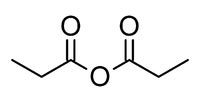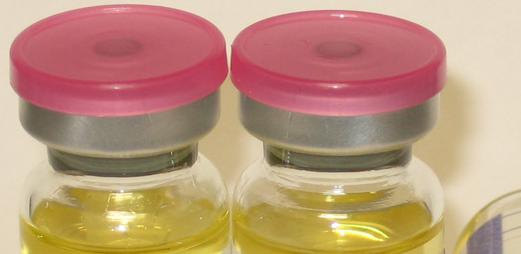HOME >>
Chemicals
>> Propionic Anhydride

|
Propionic Anhydride

|
|
PRODUCT IDENTIFICATION
CAS NO. : 123-62-6
EINECS NO. : 204-638-2
FORMULA : C2H5COOCOC2H5
MOL WT. : 130.14
H.S. CODE : 2915.90
IUPAC Name: propanoyl propanoate
TOXICITY
Oral rat LD50 : 2360 mg/kg
SYNONYMS methylacetic anhydride; Propionyl oxide;Propionic Acid
Anhydride; Propanoic Anhydride; Anhydrid Kyseliny Propionove;
CHEMICAL PROPERTIES
PHYSICAL STATE : clear liquid
MELTING POINT : -45 C
BOILING POINT : 167 C
SPECIFIC GRAVITY : 1.01
SOLUBILITY IN WATER Insoluble (decomposes slowly) pH
VAPOR DENSITY : 4.5
AUTOIGNITION : 285 C
NFPA RATINGS Health: 3 Flammability: 2 Reactivity: 1
REFRACTIVE INDEX : 1.403 - 1.405
FLASH POINT : 63 C
STABILITY : Stable under ordinary conditions
Synonyms:
propionove;anhydridkyselinypropionove;C2H5C(O)OC(O)C2H5;Methylacetic
anhydride;methylaceticanhydride;Propanoicacid,anhydride;Propinoicanhydride;propionic;Propionic
acid anhydride;propionicacidanhydride;Propionyl
oxide;propionyloxide;PROPANOIC ANHYDRIDE;PROPIONIC
ANHYDRIDE;Propionic Anhydried;Propanic Anhydride;PROPIONIC
ANHYDRIDE, 99+%;PropionicAnhydrideForSynthesis;Propionic
anhydride 97%;PROPIONSAEUREANHYDRID |
DESCRIPTION AND APPLICATIONS
Propionic anhydride is a clear liquid with an unpleasant odour. It
hydrates with water producing corrosive propionic acid. It is
miscible in most organic solvents and decomposes with alcohol.
Propionic anhydride used as an intermediate to produce dyes,
pharmaceuticals, agrochemicals and other organic compounds.
SPECIFICATION
 APPEARANCE
: clear liquid APPEARANCE
: clear liquid
CONTENT : 98.0% min
PROPIONIC ACID : 2.0% max
OTHER INDIVIDUAL IMPURITY : 0.5% max
COLOR : 20 max (Pt/Co scale)
PACKING : 200lgs in drum
HAZARD : CLASS 8 (Packing group : III)
GENERAL DESCRIPTION OF ANHYDRIDE
Anhydride is a compound formed by the abstraction of a molecule of
water, H2O, from a substance. The term acid anhydride is restricted
sometime to the anhydride formed especially from an acid by
dehydration or one that revert to the original substance upon
hydration. In case of bimolecular, it can be composed of two
molecules of the corresponding acid. The term mixed anhydride is an
acid anhydride composed of two different acids. Examples are
adenosine triphosphate or an aminoacyl adenylate. The anhydrides of
bases are oxides.
Anhydrides of inorganic acids are usually oxides of nonmetallic
elements. Carbon dioxide (CO2) is the anhydride of carbonic acid,
dinitrogen pentoxide (N2O5) is the anhydride of nitric acid, sodium
oxide is an anhydride of sodium hydroxide, phosphorus pentoxide
(P2O5) is the anhydride of phosphoric acid, and sulfur trioxide
(SO3) is the anhydride of sulfuric acid. An acid anhydride forms an
acid; a base anhydride forms a base. Sulfur trioxide (acid
anhydride) reacts with water to form sulfuric acid (an acid
product). Calcium oxide (an base anhydride) reacts with water to
form calcium hydroxide (a base product).
Organic anhydrides contain the carbonyl group (CO). Organic
anhydrides are formed by the condensation of original acids. Lactone,
an internal cyclic monoester, is an anhydride derived from the
hydroxyl and carboxyl radicals. In organic chemistry, most anhydride
compounds are derived from corresponding carboxylic acids.
Carboxylic anhydrides, general formula (RCO)2O, are the dehydration
product of two carboxylic acid molecules. The name of carboxylic
anhydride is given first from the original acid, followed by the
separate word "anhydride". [CH3(CH2)2CO]2O is butanoic anhydride,
CH3COOCOCH2CH3 is ethanoic propanoic anhydride (or acetic propionic
anhydride). Anhydrides are more reactive than the parent acids.
Anhydrides are typically not target molecules, but rather they are
used as intermediates for the synthesis of other organic members
such as esters and amides for the industrial applications include
dyes, pharmaceuticals, pesticides, plastics, fibers, curing agents,
plasticizers and many others. The reactivity of carboxylic acid
derivatives are in order of acyl halides > anhydrides >> esters ¡Ö
acids >> amides. Anhydrides react with alcohols to form esters;
acetic anhydride [(CH3CO)2O] reacts with ethanol (C2H5OH) to form
ethyl acetate (CH3COOC2H5) used as a common solvent. Anhydrides also
react with ammonia and primary or secondary amines to form amides.
Anhydrides react with water to form their corresponding acids.
Uses
Propionic anhydride is chiefly used as a raw material for cellulose
acetate propionate, a plaxtic found in face shields, sunglasses,
brush handles, toys, cosmetics containers and blister packages.
Propionic anhydride is also a raw material for dyes,
pharmaceuticals, agrochemicals and fragrance chemicals
Propionic anhydride is an organic compound with the formula
(CH3CH2CO)2O. This simple acid anhydride is a colourless liquid.. It
is a widely used reagent in organic synthesis.
Synthesis
Propionic anhydride has been prepared by dehydration of propionic
acid using ketene
Safety
Propanoic anhydride is strong smelling and corrosive, and will cause
burns on contact with skin. Vapour can burn eyes and lungs.
STORAGE
Separated from acids, bases, oxidants, food and feedstuffs. Dry.
Ventilation along the floor.

 Note:
These API/ chemicals are designated as those that are used in
the manufacture of the controlled substances and are important to
the manufacture of the substances. For any (Control Substance)
products Import and Export *** subjected to your country government
laws /control substance ACT. Note:
These API/ chemicals are designated as those that are used in
the manufacture of the controlled substances and are important to
the manufacture of the substances. For any (Control Substance)
products Import and Export *** subjected to your country government
laws /control substance ACT.
Note /Government Notification: N/A

|

|


